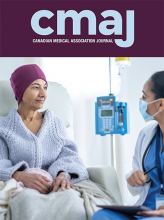This issue of CMAJ features Brenner and colleagues’1 projections for cancer diagnoses in Canada in 2024. Despite overall declines in cancer incidence and mortality, population growth and aging will drive an increase in the absolute number of people receiving a diagnosis of cancer this year. This is a daunting prospect, considering that many people with worrisome signs or symptoms of cancer already face circuitous and frustrating paths to obtain a diagnosis and start treatment. Receiving a diagnosis of cancer in an emergency department is becoming routine in Canada, which highlights the failure of health care systems to support adequate primary care–initiated pathways for diagnosis of suspected cancer. One in 5 people in Canada do not have a regular primary care provider and, even among those who do, many report poor access to primary care.2 Moreover, wait times for diagnostic imaging vary widely, and some patients wait months for diagnostic imaging for suspected cancer.3 We discuss how expanding access to streamlined paths for cancer diagnosis is critical to ensure the gains that have been achieved in cancer screening and treatment are not lost amid inefficiencies in health care systems.
Between 2012 and 2017, 26.1% of patients with cancer in Ontario received their diagnosis as part of an emergent presentation requiring urgent hospital admission as a consequence of an emergency department visit.4 As emergency physicians, we perceive that this proportion has increased substantially in the pandemic recovery period. People who have an emergency department visit associated with their cancer diagnosis are often older, do not have access to primary care, come from minority backgrounds, or have lower socioeconomic status than those who do not have an emergency department visit associated with their cancer diagnosis.5 They also have worse cancer-related outcomes, such as higher stage at diagnosis and worse overall survival.6
Patients with symptoms of suspected cancer, such as unexplained weight loss or a palpable mass, are seen in the emergency department because it is one of the few places where urgent diagnostic imaging or other tests can be arranged. Although access to testing may be expedited, an emergency department is an unfortunate place to be told “you may have cancer.” One important reason is that emergency departments are now routinely overcrowded, with patients receiving care in spaces like waiting rooms, hallways, and utility closets. In a qualitative study of patients who found out they had gastrointestinal cancer during an emergency department visit, patients overwhelmingly reported the lack of privacy as distressing and inappropriate.7 Patients also leave the emergency department with uncertainty about follow-up and treatment plans, let alone prognosis.
Another reason that emergency departments are a terrible place to receive a cancer diagnosis is that most of them do not routinely have processes in place to confirm a cancer diagnosis, such as arranging and following up on biopsies or ordering other diagnostic tests that are often necessary for referral to a cancer specialist.8
Single-entry referral models for patients with suspected cancer may be a potential solution to facilitate further testing and improve access to specialist follow-up. When specialist referrals are made using a single point of entry and a coordinated approach to triage, the time from referral to consultation decreases, and patient and provider satisfaction is higher than before implementation of the single-entry model.9 Given the projected increase in cancer diagnoses and use of emergency departments to facilitate diagnostic testing, all emergency departments should have access to a single, streamlined, and uniform process for any patient with a new suspected diagnosis of cancer.
To address increasing medical complexity and the large proportion of patients without family physicians, hospitals are also piloting navigation programs after discharge from emergency departments to ensure that follow-up care for patients with complex medical conditions occurs as planned.10,11 These have been adapted from the broadly implemented navigation programs for patients with cancer,12 whereby phone calls and email communication between the clinician–navigator and patient may mitigate some patient uncertainty and distress after receiving a new or suspected cancer diagnosis in the emergency department.
Patients may not need an emergency department visit at all if access to outpatient clinics that streamline the diagnosis of suspected cancer is increased. In Ontario, several diagnostic assessment program (DAP) clinics are available for the work-up of certain cancers, such as lung, colorectal, and breast cancer.13 A person with a suspicious lung mass on chest radiography can be referred, and the DAP clinic will arrange for further imaging, biopsy, and management, as needed. Studies of patients with lung cancer in Ontario have shown that people assessed through DAP clinics had earlier treatment and improved survival.14,15 Expanding access to diagnostic clinics for suspected cancers and increasing their regional availability may help ensure timely work-up and management.
Brenner and colleagues’1 projections serve as a reminder that successes in prevention, screening, and treatment of cancer lead to a decline in the incidence of cancer and associated mortality. Continued efforts to increase awareness of early cancer symptoms, reduce barriers to cancer screening, and increase capacity for its early diagnosis in primary care and hospitals are critical. To lose the gains made in cancer outcomes to the overcrowding, fragmentation, and inefficiencies of health care systems would be a tragic shame.
Footnotes
Competing interests: Keerat Grewal reports funding from the Canadian Institutes of Health Research and the Canadian Association of Emergency Physicians. Catherine Varner’s competing interests can be found at www.cmaj.ca/staff.
This is an Open Access article distributed in accordance with the terms of the Creative Commons Attribution (CC BY-NC-ND 4.0) licence, which permits use, distribution and reproduction in any medium, provided that the original publication is properly cited, the use is noncommercial (i.e., research or educational use), and no modifications or adaptations are made. See: https://creativecommons.org/licenses/by-nc-nd/4.0/











